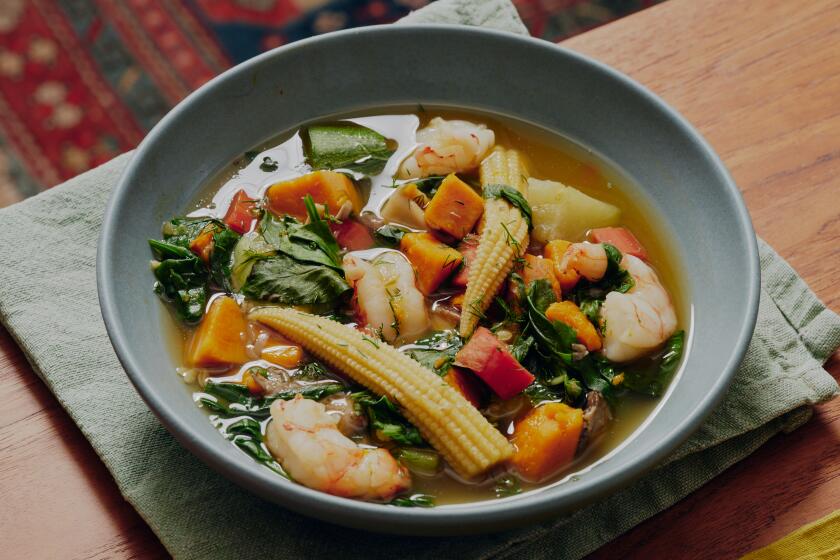Nam khao tod

- Share via
When Kris Yenbamroong was in junior high in Thailand, he went to an exclusive private school. But somehow, he says, he always found himself eating lunch not with his well-heeled classmates but with the groundskeepers and maintenance guys. It’s a perspective that has come to define his cooking.
Yenbamroong, from a four-generation restaurant family, is the chef at Night + Market and Night + Market Song, which both specialize in rough-edged Thai country food, cooked with a modern sensibility.
One terrific example is his nam khao tod, a salad made with crunchy rice generously spiked with funky fish sauce, Thai chiles, peanuts, raw ginger and naem, a sour Thai fermented pork sausage. It’s the most popular dish on the menu — he says 30 are served a night — and it’s one that has inspired a craving approaching obsession among many fans.
“This is the dish I tell everyone to start with at the restaurant because it has so much going on,” he says. “Start with this and you will know all the flavors that are going to come for the rest of the meal.”
Nam khao tod is a traditional dish from Laos and northern Thailand. Sometimes it’s made by pressing wet cooked rice into balls before frying (in Laos, sometimes coconut and an egg coating are added). The exterior is then broken off in chunks that are both crisp and chewy.
Night + Market’s version embraces the same big flavors but with the added polish of the rice being carefully dried before frying so it has a flavor and texture something like chile-spiked savory Rice Krispies. This is accomplished only by repeatedly rubbing the cooked rice grains with rice flour between your thumb and palm until each is dry and separate.
“That [more rustic version] makes an amazing dish but one that’s different than this,” Yenbamroong says. “This is the most popular dish on my menu, but if I served that other one, it probably wouldn’t be. It’s definitely more esoteric flavor-wise, and it’s not nearly as approachable.”
The 33-year-old Yenbamroong’s parents owned Talesai on Sunset Boulevard, one of the first mainstream Thai restaurants in Southern California (it has been absorbed into Night + Market). The main chef there was his grandmother Vilai. But the family cooking tradition probably starts, he says, with his great-grandmother on his father’s side, who was a market cook in Thailand.
When Yenbamroong was in his teens, the family moved back to Thailand for several years, where he attended that international private school.
“That’s where I developed a lot of my taste for things. There were a lot of rich kids at the school, and the cafeteria had a sushi station and a hamburger bar. But I ended up befriending a lot of the staff. For me it was really important to connect with the Thai side of my life.
“I’d hang around with them and they’d open their lunchboxes, and they always had the best food. I mean, I came from L.A. I had had enough burgers. I wanted real Thai food.”
Not just real Thai food, but Thai country food, which Yenbamroong says is a lot rougher than what you’d find in the city, with big, bold flavors.
“It’s really crass — and I say that with reverence. It’s really direct, really delicious. With central Thai food, at its best you get nuance and subtlety, but with country food it’s right in your face.
“Things like soured pork, lots of stuff that’s half-rotten, like fermented fish sauce. Fish sauce is already pretty strong, but fermented fish sauce is a whole different level of stink. But once you add a little to a dish, it adds a depth of flavor that you can’t achieve with anything else.”
Fluff the rice and spread it out on a baking sheet. Chill the rice, uncovered, until ready to fry, at least 1 hour.
Remove the rice and season it with salt and red curry paste, mixing it in by hand to separate the rice into individual grains. Taste and adjust the seasoning if desired.
Sprinkle a few tablespoons of rice flour over the seasoned rice and continue working by hand, gently rubbing the rice to separate it into individual grains. Add more rice flour a little at a time as necessary. When you are done, the rice should feel very dry and separate. Return it to the refrigerator for 30 minutes to finish drying.
Meanwhile, add enough vegetable oil to a deep pot so it goes halfway up the sides. Heat the oil until a thermometer inserted reaches 355 degrees.
Rain in the rice, a handful at a time, to the oil. The oil will bubble profusely and slowly settle down as the rice fries to a light golden color. When the bubbles have subsided, about 45 seconds, remove the rice, using a fine mesh strainer, to a paper towel-lined tray to drain. Repeat with the remaining rice.
In a large bowl, combine the chile jam, sugar and fish sauce, stirring or whisking until combined to form a sauce. Stir in the red chile flakes, Thai chiles, red onion, green onion, cilantro and lime juice. Fold in the sausage, peanuts and ginger, then the rice, tossing quickly to mix. Divide the mixture into servings, and garnish each with a little more chopped cilantro. Serve immediately.
Get our Cooking newsletter.
Your roundup of inspiring recipes and kitchen tricks.
You may occasionally receive promotional content from the Los Angeles Times.
















